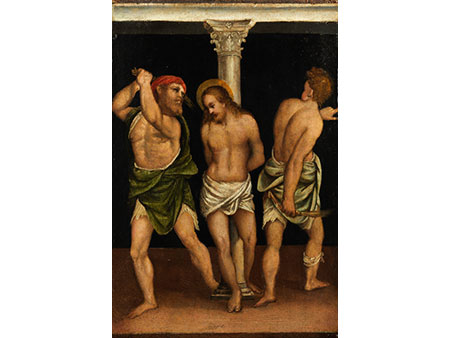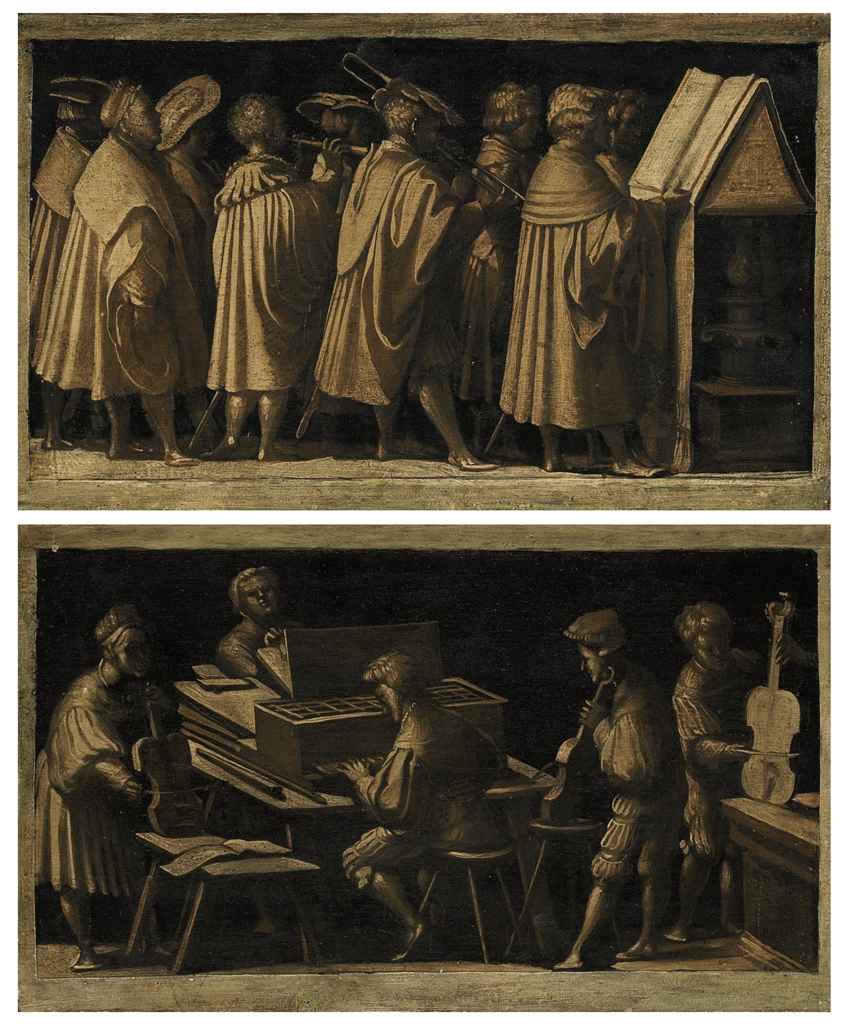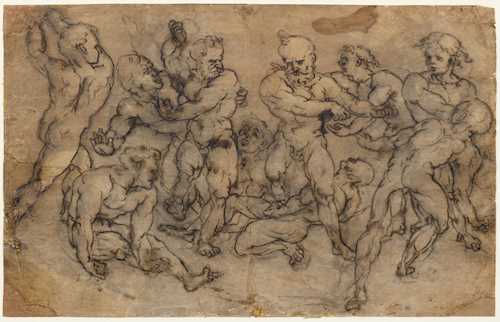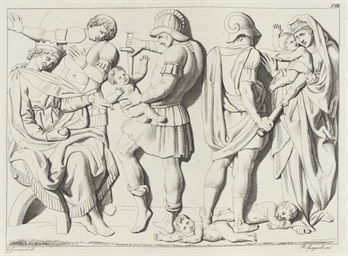Amico AspertiniBologna 1474 - 1552Recto: Study for an illustration of a popular proverbVerso: A corpse being dragged in the street of a city: the transportation of the body of St. Christopher Black chalk and brown wash, on paper washed beige (recto and verso);bears pencil attribution verso: Amico Aspertini (twice), numberings in red and blue chalk: 97 and 32, and pencil numbering: 79163/J ph.190 by 245 mm ProvenanceGeorg and Wilhelm Denzel (their collector's mark, verso, not in Lugt)Catalogue noteThe recto of this drawing, which must illustrate a popular proverb, is typical of Aspertini's graphic style, and also of his eclectic and eccentric mind. As Philip Pouncey observed, Aspertini had 'a riotous imagination with a strong leaning to the grotesque...'1 and even Giorgio Vasari described him as 'uomo capriccioso e di bizzarro cervello..' ('a capricious man with a bizarre brain..').2 Philip Pouncey has also rightly noted that these unconventional characteristics qualify the artist 'to please modern taste.' Popular and folk imagery had a prominent place in Bolognese culture of the 16th century, a tendency which became intertwined in the second half of the century, especially in the work of Bartolomeo Passerotti (1529-1592), with the representation of genre scenes emphasising the comic and grotesque aspects of daily life. The subject of the composition on the verso is also depicted, though in a vertical format, on a sheet from an album of drawings by Aspertini at the British Museum (so-called London II: Folio 13 recto, numbered 25), which has been dated to 1530-40. The British Museum drawing has been identified as an adaptation of Mantegna's fresco of St. Christopher in the Ovetari chapel, in the church of the Eremitani, Padua.3 In the present sheet, Aspertini focuses on the figures in the composition, only suggesting the architectural setting in the background. 1. P. Pouncey, 'Drawings by Innocenzo da Imola,' Master Drawings, vol. VII (1969), no. 3, p. 2872. G. Vasari, Le Vite de' più eccellenti pittori scultori ed architettori.., Milan 1880 (ed. G. Milanesi), vol. V, p. 179 3. London, British Museum, inv. no. 1862,0712.406; P.P. Bober, Drawings after the Antique by Amico Aspertini Sketchbooks in the British Museum, London 1957; M. Faietti - D. Scaglietti Kelescian, Amico Aspertini Modena 1995, p. 68, reproduced fig. 51
Amico AspertiniBologna 1474 - 1552Recto: Study for an illustration of a popular proverbVerso: A corpse being dragged in the street of a city: the transportation of the body of St. Christopher Black chalk and brown wash, on paper washed beige (recto and verso);bears pencil attribution verso: Amico Aspertini (twice), numberings in red and blue chalk: 97 and 32, and pencil numbering: 79163/J ph.190 by 245 mm ProvenanceGeorg and Wilhelm Denzel (their collector's mark, verso, not in Lugt)Catalogue noteThe recto of this drawing, which must illustrate a popular proverb, is typical of Aspertini's graphic style, and also of his eclectic and eccentric mind. As Philip Pouncey observed, Aspertini had 'a riotous imagination with a strong leaning to the grotesque...'1 and even Giorgio Vasari described him as 'uomo capriccioso e di bizzarro cervello..' ('a capricious man with a bizarre brain..').2 Philip Pouncey has also rightly noted that these unconventional characteristics qualify the artist 'to please modern taste.' Popular and folk imagery had a prominent place in Bolognese culture of the 16th century, a tendency which became intertwined in the second half of the century, especially in the work of Bartolomeo Passerotti (1529-1592), with the representation of genre scenes emphasising the comic and grotesque aspects of daily life. The subject of the composition on the verso is also depicted, though in a vertical format, on a sheet from an album of drawings by Aspertini at the British Museum (so-called London II: Folio 13 recto, numbered 25), which has been dated to 1530-40. The British Museum drawing has been identified as an adaptation of Mantegna's fresco of St. Christopher in the Ovetari chapel, in the church of the Eremitani, Padua.3 In the present sheet, Aspertini focuses on the figures in the composition, only suggesting the architectural setting in the background. 1. P. Pouncey, 'Drawings by Innocenzo da Imola,' Master Drawings, vol. VII (1969), no. 3, p. 2872. G. Vasari, Le Vite de' più eccellenti pittori scultori ed architettori.., Milan 1880 (ed. G. Milanesi), vol. V, p. 179 3. London, British Museum, inv. no. 1862,0712.406; P.P. Bober, Drawings after the Antique by Amico Aspertini Sketchbooks in the British Museum, London 1957; M. Faietti - D. Scaglietti Kelescian, Amico Aspertini Modena 1995, p. 68, reproduced fig. 51





.jpg)









Try LotSearch and its premium features for 7 days - without any costs!
Be notified automatically about new items in upcoming auctions.
Create an alert